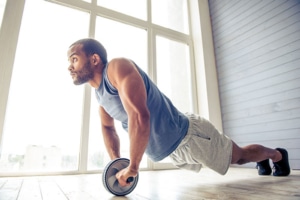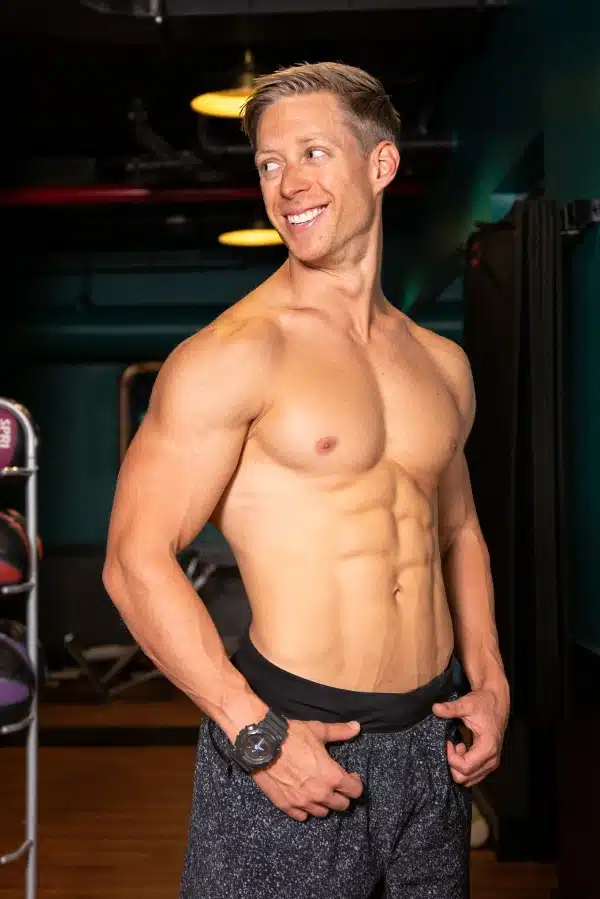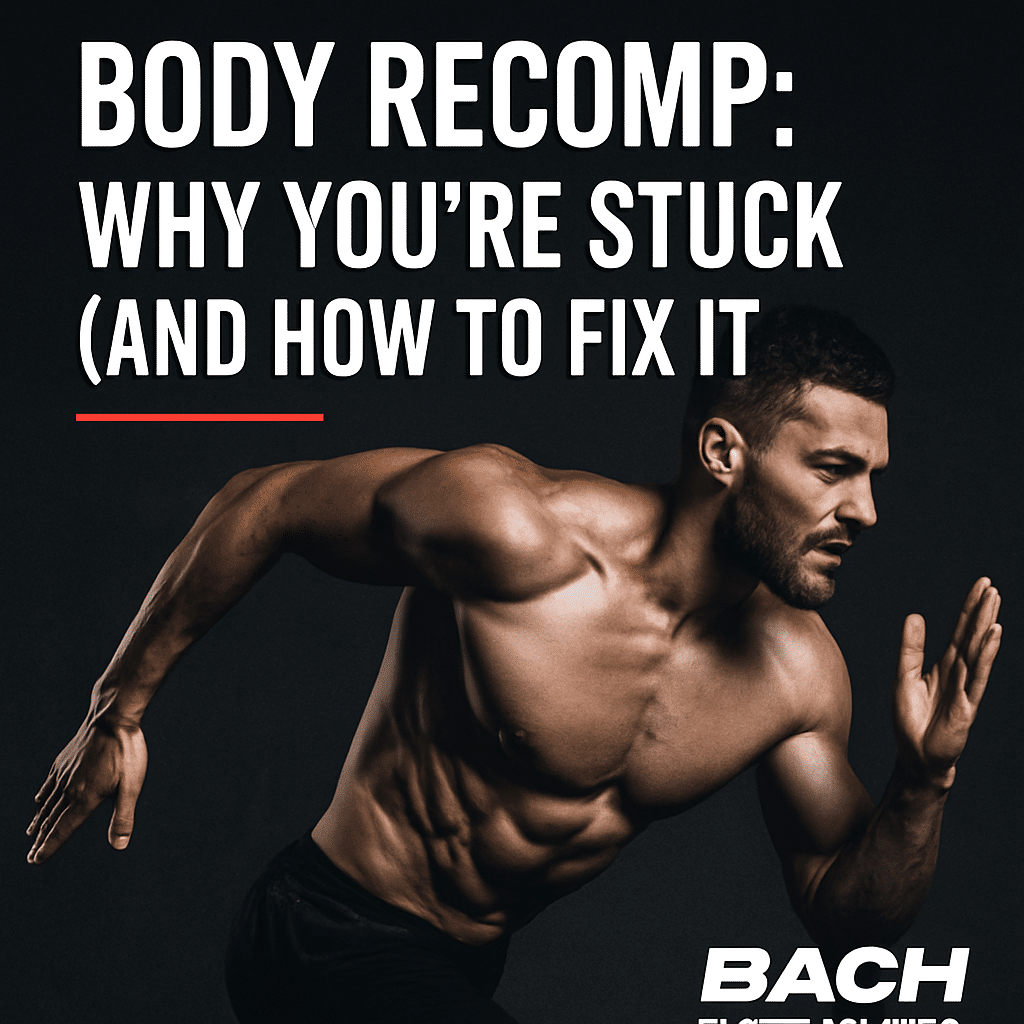No B.S Core Training For Great Abs, Powerful Athleticism, and a Healthy Back (3-D Core Training, Part One)
May 15, 2018
Conflicting theories are everywhere when it comes to training your core.
Instagram fitness models preach the benefits of a crunching gizmo or (gasp) a vibrating belt.
The “functional” trainer at the gym (who doesn’t even lift) points to a BOSU ball and an endless variety of planks and some exercise called a “dead-bug.”
And the meatheads across the gym? “Squat and deadlift, bro. That’ll get your core strong.”
With misinformation flowing with less restriction than your Facebook data, no wonder you’re confused.
Allow me to clarify in the first of three core training posts.
The primary goal of any good core workout is injury prevention.
After all, a healthy core allows you to move freely and look good on the beach…without worrying you’ll tweak your back picking up a frisbee or wiping the sand from your feet.
Learning to train correctly will help you perform better, avoid back pain and other injuries, and be stronger in everything that you do. That’s true whether you’re squatting seriously heavy weight, shoveling snow, or picking up your child.
But first, what do we really mean when we say “core?”
Let’s start first by looking at your abs. Your abs are one muscle, the rectus abdominis (RA). The RA is what gives people that six-pack (or eight-pack) look, but still only makes up a fraction of what we call the “core.”
Your RA works with your obliques (internal and external), which run along the side of your torso and aid in rotating your core, like a golf swing. They’re also what you poke in the ole’ love handle region.
You also have a few other partners lurkin’ in the deep end with your transverse abdominous, quadratus lumborum, and multifidi that increase intra-abdominal pressure and help control the movements of your spine to prevent injury. And if you’re looking for a simple guide to build a rock-solid, lean physique, grab your guide below.
Now, unless you’re studying for an anatomy exam, there’s no need to understand these in-depth. Just know something about their overall role.
 Together, deep and superficial muscles work like a drawbridge, providing struts and cables attaching to your spine.
Together, deep and superficial muscles work like a drawbridge, providing struts and cables attaching to your spine.
They must be fatigue resistance to reduce annoying back pain and capable of holding a rigid position when lifting heavy weights, so you don’t fold like an accordion and end up in the ER.
These muscles also work together to move, whether it’s doing a crunch, swinging a golf club, or rotating your spine to smack the backseat driver in your car.
The real battle of core training? Due to the multi-functional demands on your core, every muscle matters.
That’s why most abs workouts are inherently flawed.
Training your abs directly through a movement like sit-ups or crunches (not the best bang-for-your-buck exercises) won’t accomplish what you want. Instead, you must enter phase one of a proper core training proper. Focus on activating dormant muscles to keep you strong and healthy.
It sounds funny, but you need to make sure that all of your core muscles are awake and not asleep at the switch. That’s why a progressive approach is best. It puts you in control of your abs. Think of it as being like building a skyscraper.
If you start piling on floor after floor of office space without first building a solid foundation, there’s a good chance your structure will crumble.
You need to build the strong foundation. A core routine focused on preventing movement is that foundation.
Phase 1: Injury Prevention
Here’s where you reinvigorate tissues that are often deactivated by your lifestyle. This is a way bigger deal than you think.
Look no further than your typical workday to understand why. Your commute begins and ends with sitting in the car for 15-30 minutes, keeling forward over your steering wheel.
You’re in a seat keeled over your computer and hunched over your screen all day long. Rinse, repeat, then hop back in your car and repeat again.
Rinse and repeat some more for eight to 12 hours per day, 300 days per year.
After long-term sitting, the deep #science muscles we mentioned before weaken and shut down from inactivity. Even big muscles like your glutes shut off, giving you the dreaded pancake butt. They stop working as they should. Leading spinal researcher Dr. Stu McGill has dubbed this phenomenon gluteal amnesia
The result is terrible posture, worse gym performance, and far higher risk of back pain.

Forgettaboutit.
I have a better idea: let’s train the core with a multi-faceted plan to reuse underused muscles and build a baseline of strength and endurance for your core.
These movements are best as part of a warm up before your workout. Alternatively, they can be a targeted program for four weeks if you find that these exercises are challenging. That’s because your small stabilizers and glutes are “turned off.”
All About Back Pain (And How To Prevent It)
Back pain is debilitating.
Whether you have difficulty standing for long periods of time or trouble sitting or bending over to tie your shoe…back pain makes basic activities we take for granted a constant pain.
The first goal of your core training to injury prevention. We’ll take care of this at the beginning of your workout with core activation work. Core activation is a series of core exercises that “wake up” all of the muscles in your trunk to prevent injury and boost performance. Pst, here’s a step by step guide to build a high-performance body and look great naked, without living in the gym.
Your abs workout injury prevention focuses on preventing movement with the “anti” movements.
Anti-Rotation: Rotating your spine is part of life and most sports, but it’s something you must do with caution. The American Academy of Orthopedic Surgeons has stated “twisting while you lift can make you vulnerable to herniating discs in your back.”
Further, Physical therapist Shirley Sahrmann writes “Many low back problems occur because the abdominal muscles are not maintaining tight control over the rotation between the pelvis and the spine at the L5- S1 level.”
Herein lies the problem: rotation is part of everyday life. Yet too much can lead to injury.
You must be able to prevent rotation before you’re ready to train rotational movements. The best way to build stability from the ground up and prevent rotation is through anti-rotation exercises.
The best pallof presses, half-kneeling iso-holds, and half-kneeling chops. Compound exercises like a single-arm dumbbell row also fit the bill.
Anti-Extension: Resist extension of the spine, like arching your lower back. Anti-extension exercises train your core to resist this extension. This prevents you from doing things like rounding your back on deadlifts.
Try front planks, ab wheel rollouts, and stability ball rollouts.

Anti-Lateral Flexion: That’s the scientific way of saying “resisting sideways bending.” True anti-rotation exercises are done to resist rotation at the lumbar spine. Now and then you’ll see someone with a wooden dowel or barbell on their shoulders, rotating side to side to “loosen the back.” Unless you fantasize about disk herniations and walking like a hunchback, please avoid shit like that. Yes, some athletes need explosive rotational capabilities.
But this is built on a foundation of strength and anti-rotation stability first.
To train it, perform side plank variations, single-arm farmer’s carries, and carrying your groceries all in one hand. There’s one other crucial factor here….
Glute Engagement
Your glutes are the biggest muscle in your body and responsible for driving hip extension, the main muscle action for moves like sprints, jumps, deadlifts, and squats.
The only problem?
Well, most of us sit on our glutes all day. This leads to poor muscle function and the inability to fire your glutes without flexing through your lower back.
Improving glute activation is far and away one of the best things you can do to reduce back pain, improve performance, and build a strong, resilient body.
The glute muscles extend hip (lock out a lift, push-off into a sprint), abduct (bring your leg away from the middle of your body), externally rotate (turning your leg out), and internally rotate (turning your leg in) the hip joint.
To activate your glutes, try quadruped hip extensions, frog pumps, clamshells, lateral band walks and x-band monster walks. For strengthening your glutes, go with compound exercises like squats, hips thrusts, deadlifts, and lunges with a focus on full hip extension and a glute squeeze at the top of a movement.

The above list should give you plenty of options for compiling a core and glute workout or warmup. But we’ve taken things a step further for you and built a couple of examples you can use before an upper-body or lower body workout. Try these before your next strength session:
Sample Abs Workout (Before Upper Body Workout)
1a. TRX Fallout, 2×10, rest 30 seconds
1b. Side Plank, 2×45 seconds/side, rest 30 seconds
1c. Hip Thrust, 2×10, rest 30 seconds
Sample Abs Workout (Before Lower Body Workout)
1a. Half Kneeling Pallof Press, 2×10/side, rest 30 seconds.
1b. Lateral Band Walk, 2×10/side, rest 30 seconds
The Takeaway: Control Your Core
Back injuries can be a death sentence for building a high-performance body.
And injuries tend to happen because of either poor technique or poor strength-activation of core muscles. Technique is a case-by-case issue and should be fixed independently. Activation, however, is something you can control, and it starts BEFORE you even touch a barbell.
Most lifters work the typical desk job, sitting in the same position for 8-12 hours a day, 300 days per year.
This makes jumping into a similar flexed position (deadlift, squat) risky. By training your core first in the workout, you’re activating dormant muscles that spend most of the day relaxing so you can build strength and muscle without beating up your back.
If the muscles primarily responsible for preventing unwanted movement and transferring force to your core isn’t activated and working, how can you expect them to prevent your spine from folding once you add a heavy weight, try to play a sport, or worse, even tie your shoe?
You can’t.
Let’s change that today. With the Power Primer workout, you’ll have the perfect 16-week blueprint to build a strong, lean, and athletic body without beating up your joints. Grab your copy today.









